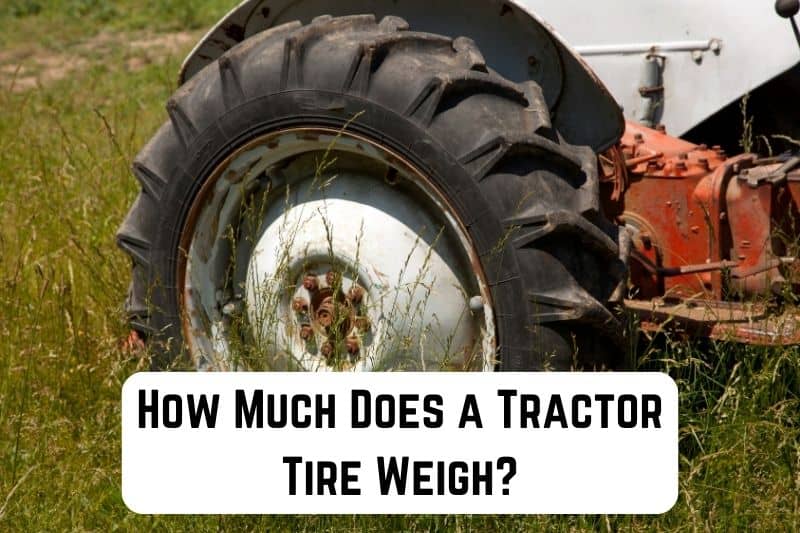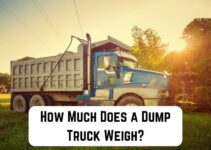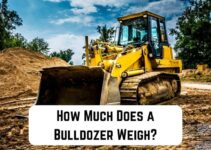As a farmer or tractor owner, you’ve probably wondered about the weight of your tractor tires at some point. Understanding the weight of these massive rubber rings is essential for various reasons, including proper maintenance, safety, and even the performance of your tractor.
To give you a better understanding of how much a tractor tire may weigh, let us explore the aspects that primarily affect its mass. Throughout this article, I will provide some helpful examples and tips for determining the weight of your tractor tire.
Read: How Much Does an ATM Weigh? (Full Guide)
Tractor tires vary in size and weight depending on the tractor’s type, model, and use. They can weigh between 100 and 1000+ pounds due to tire size, rubber type, and construction.

Understanding Tractor Tire Weight
Regarding tractor tires, I always find it fascinating to learn about their weight. The weight of a tractor tire primarily depends on factors like its size, tread type, and manufacturer. Let’s look at some examples of tractor tire weights to give you an idea.
Radial vs Bias Ply Tires
Tractor tires come in two types: Radial and Bias Ply. Radial tires usually weigh more than Bias Ply tires because of their construction. They have more steel belts and fabrics integrated into the tire, making them more durable and longer-lasting.
Example Weights
Here are some examples of tractor tire weights, considering that these approximate values may vary between manufacturers.
- Small tractor tires (front): 60 to 200 pounds
- Small tractor tires (rear): 250 to 350 pounds
- Large tractor tires (front): 300 to 700 pounds
- Large tractor tires (rear): 700 to 2,000 pounds
As you can see, rear tires generally weigh more than front tires because they support a larger portion of the tractor’s weight and require more strength to handle the load.
Factors Affecting Tractor Tire Weight
As I began researching tractor tire weights, I discovered no one-size-fits-all answer. Several factors influence the weight of a tractor tire. In this section, I will discuss some of these factors to help you understand how they affect the overall weight.

- Tire Size: The size of a tractor tire plays a significant role in determining its weight. Naturally, the larger the tire, the more it weighs. Tractor tires come in various sizes, so those with larger diameters and wider dimensions will weigh more than smaller ones.
- Tire Construction: The construction of a tractor tire also affects its weight. There are two main types of tractor tires: bias and radial. Bias tires are made using layers of nylon or polyester, while radial tires involve steel belts. Radial tires are generally heavier, providing better traction and durability.
- Tread Depth: The depth of a tractor tire’s tread affects its weight as well. Deeper treads mean more material is used in the tire, increasing its weight. Thicker treads provide better grip and traction, especially on wet or muddy terrain. However, these added benefits come at the cost of a heavier tire.
- Materials Used: The types and compositions used in manufacturing a tractor tire play a role in determining its weight. Rubber compounds can vary in composition, which results in variations in weight. Reinforced materials like steel belts also contribute to the overall weight of a tire.
Different Types of Tractor Tires and Their Weights
In this section, I will discuss two main types of tractor tires: Bias Tires and Radial Tires. I will also provide information on their weights so that you can have a better understanding of each type.

Bias Tires
Bias tires are a traditional choice for tractors. They have a rugged construction consisting of multiple layers of rubber and fabric diagonal to each other. This design provides:
- Durable sidewalls
- Resistance to punctures and cuts
- A more affordable price
Weights of bias tires can vary depending on size and construction, but a typical range is 200 to 800 pounds. Here are some examples of bias tractor tires and their weights:
Radial Tires
Radial tires are more modern compared to bias tires. They have a different internal structure, consisting of rubber layers placed radially from the tire’s center with steel belts underneath. Some benefits include:
- Improved traction
- Better ride quality
- Longer lifespan
Radial tractor tires usually weigh more than bias tires, with a standard range of 300 to 1,000 pounds. Here are some examples of radial tractor tires and their weights:
Impact of Tractor Tire Weight on Performance

I have found that the weight of a tractor tire plays a significant role in the overall performance of the vehicle. As a tractor owner, it’s essential to understand how the tire weight affects things like traction, fuel efficiency, and maneuverability to make an informed decision when choosing your tractor tires.
Heavier tractor tires improve grip and stability on uneven terrain or muddy conditions by distributing pressure evenly across the contact area.
Heavier tractor tires impact fuel efficiency. More rolling resistance means the engine works harder, leading to increased fuel consumption and higher operating costs. As a tractor owner, balancing traction and fuel efficiency is crucial to minimize costs and environmental impact.

Maneuverability is another factor impacted by tractor tire weight. Heavier tires can make the tractor feel sluggish and unresponsive, especially when turning or navigating tight spaces. Lighter tires, on the other hand, might be more maneuverable but might not provide the same level of traction as heavier tires.
When selecting the right tractor tire, you must consider factors like the type of work you’ll be doing and the conditions you expect to encounter. For example:
- For general agricultural work and road use, a moderately weighted tire might be the best option.
- For heavy-duty work such as construction or logging, a heavier tire may be necessary to provide the required grip and stability.
Choosing the right tractor tire requires balancing traction, fuel efficiency, and maneuverability. Invest time and research to make the right decision that suits your needs.
How to Measure Tractor Tire Weight?

When I need to measure the weight of a tractor tire, I always start by gathering the necessary tools, such as a scale, measuring tape, and any technical information from the tire manufacturer.
Read: How Much Does a Mango Weigh? (Answer Inside)
In case the product data is not readily available, I can still determine the weight by following these steps:
- Identify the type of tire: Knowing the type of tire is essential. There are two main types of tractor tires: radial and bias-ply. Radial tires usually carry less weight compared to bias-ply tires. Familiarize yourself with the tread pattern and sidewall markings to determine the type of tire.
- Measure the dimensions of the tire: Using a measuring tape, measure the height (diameter) and width of the tire. Make a note of these measurements. These will be useful for calculating the volume and weight of the tire.
- Determine the volume of the tire: To calculate the volume of the tire, I use the formula for the volume of a cylinder: π x radius² x height. Here, the radius is half the width, and the height is the measurement we took earlier. Multiply the resulting volume by the number of plies (layers) of the tire.
- Obtain the density of the tire material: Tractor tires are generally made of rubber, with a density of around 1,100 kg/m³. If the tire’s specific material density is unavailable, this value can be used as a rough estimate.
- Calculate the tire’s weight: Finally, multiply the volume by the density of the tire’s material. The result will be the tire’s weight in kilograms.
Remember, this method may not produce an exact number, but it can give you a reasonable estimate of a tractor tire’s weight.
Frequently Asked Questions
What is the average weight of a tractor tire in kg?
Tractor tire weight varies by size and type. Smaller tires weigh around 50 kg, while larger ones can weigh 400 kg or more. Check the weight of the specific tire model for accurate information.
How heavy is a tractor tire in pounds?
As previously mentioned, tractor tire weights can vary greatly. Converting the weight into pounds, smaller tractor tires might weigh around 110 lbs, while larger ones can weigh over 880 lbs. Again, it’s always a good idea to consult the manufacturer’s specifications for your tire’s exact weight.
What is the weight of a tractor tire without the rim?
A tractor tire weighs slightly less without the rim, as the rim adds significant mass. The tire weight without the rim is typically 10-20% less than the total weight, depending on the tire’s size and type.
Can you provide a tractor tire weight chart?
Unfortunately, I cannot provide a specific tractor tire weight chart due to the vast range of tire sizes and types on the market. However, I recommend contacting the tire manufacturer or a trusted retailer to obtain a chart or specific information on the tires you’re interested in.
How much does a typical tire weigh for tractor tire flipping workouts?
Choose a safe and manageable tractor tire weighing 100-300 lbs (45-136 kg) for tire flipping workouts. Beginners should start with a lighter tire to avoid injuries.
What are the different tractor tire weight fluids used?
Tractor tire weight fluids increase stability. Common fluids include water, calcium chloride, antifreeze, and liquid ballast solutions. Choose based on your tractor and farm’s specific needs.







